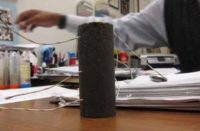The National Science Foundation supports Watershed Materials’ cutting-edge development of zero cement masonry to significantly reduce the carbon footprint of one of the world’s most common building products.
Watershed Materials, a sustainable masonry products manufacturer, has been awarded a $740,000 Phase II Small Business Innovation Research grant from the National Science Foundation to develop and commercialize structural masonry blocks with a significantly reduced carbon footprint achieved by the elimination of cement. The blocks – known as ZeroBlock – are designed as a drop-in replacement for the ordinary concrete block, also known as a cinder block or Concrete Masonry Unit (CMU).
Billions of concrete blocks are produced every year, releasing millions of tons of CO2 into the atmosphere from the high carbon emissions of cement production. Watershed Materials is developing replacements for the industry standard concrete block that will offer the same size and structural capacities with a lowered carbon footprint, use of locally sourced recycled material, and an appearance of natural stone.
Watershed Materials currently designs, manufactures and distributes a first-generation masonry block called Watershed Block that uses half the cement of an ordinary concrete block. Watershed Block was recently featured in a five page story in Dwell Magazine. Architects in the Bay Area of California are building with Watershed Block in commercial and residential projects. The National Science Foundation SBIR grant will be used to commercialize a second generation product called ZeroBlock that uses no cement in the manufacture of durable, resilient masonry. Watershed Materials anticipates a 2015 market release of ZeroBlock. Both Watershed Block and ZeroBlock incorporate recycled content such as quarry byproduct, mine tailings, and even recycled concrete in place of the virgin mined rock used in concrete.
Watershed Materials combines 21st century nanoparticle science with building systems first developed by Egyptians, Romans and Babylonians to produce beautiful, sustainable masonry. The technology behind ZeroBlock involves activating the geopolymerization of naturally occurring nanoaluminosilicates to create the structural bonds normally provided by cement. Additionally, Watershed Materials has reinvented the hydraulic block press to apply compressive forces so great as to actually lithify mineral grains, turning loose sediment into stone. These technologies have the potential to reduce the energy required to produce ZeroBlock by 90 percent compared to an ordinary concrete block.
Full details of the grant are available on the NSF website:
www.nsf.gov/awardsearch/showAward?AWD_ID=1431011
(707) 224-2532












